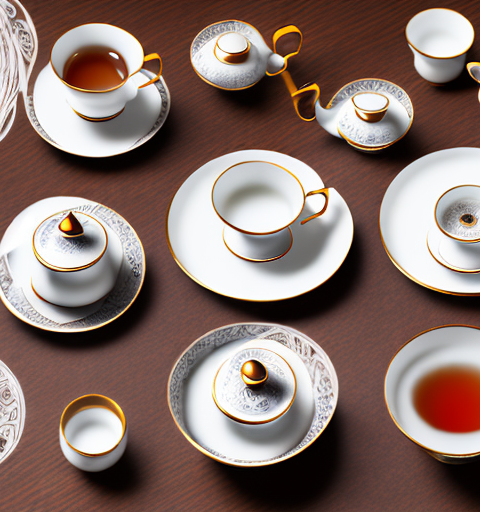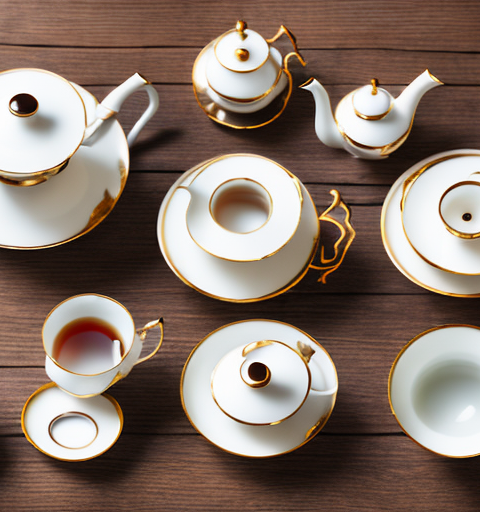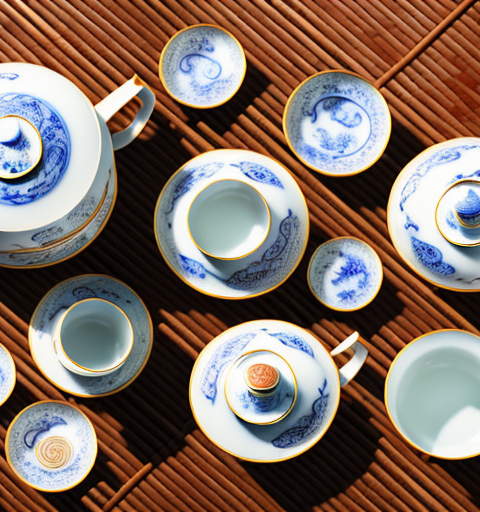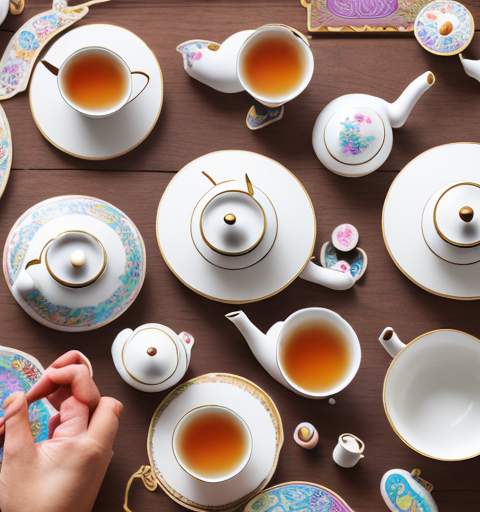A ceramic teapot is a beloved and cherished item that many tea enthusiasts rely on for their daily cup of comfort. But just how long can you expect a ceramic teapot to last?
Factors that affect the lifespan of a ceramic teapot
Several factors come into play when determining the lifespan of a ceramic teapot. One of the primary factors is the quality of the ceramic used in its construction. Ceramic teapots can be made from various types of clay, each with its own level of durability. Generally, teapots made from high-quality porcelain or stoneware tend to have a longer lifespan than those made from lower-quality clay.
Another important factor is the care and maintenance of the teapot. Proper handling and regular upkeep can significantly extend its lifespan. Exposure to extreme temperature changes, rough handling, and improper cleaning can all contribute to premature wear and tear on the teapot.
Additionally, the frequency of use and brewing methods can also impact the teapot’s longevity. Regular use, especially with high-temperature water or aggressive brewing techniques, can accelerate the wear and tear on the teapot, leading to a shorter lifespan.
Lastly, the quality of water used in brewing tea can affect the teapot’s lifespan. Hard water with high mineral content can cause mineral buildup over time, which can be challenging to remove and may impact the structural integrity of the teapot.
Furthermore, the design and construction of the teapot can also play a role in its lifespan. Teapots with intricate designs or delicate handles may be more prone to damage and may require extra care during use and cleaning. Additionally, the thickness and weight of the ceramic can impact its durability. Thicker, heavier teapots are generally more resistant to cracks and chips, while thinner, lighter teapots may be more fragile and prone to damage.
Choosing the right quality of ceramic for your teapot
When it comes to selecting a ceramic teapot with longevity in mind, it’s essential to choose a teapot made from high-quality porcelain or stoneware. These materials are known for their durability and ability to withstand daily use and frequent temperature fluctuations. Investing in a teapot made from these materials can ensure that you enjoy years of tea brewing without worrying about premature wear and tear.
Porcelain is a popular choice for teapots due to its delicate and elegant appearance. It is often associated with fine china and is known for its smooth, non-porous surface. This makes it easy to clean and resistant to staining. Additionally, porcelain teapots have excellent heat retention properties, allowing your tea to stay hot for longer periods.
On the other hand, stoneware teapots are known for their rustic and earthy charm. They are typically heavier and more durable than porcelain teapots, making them ideal for everyday use. Stoneware teapots also have excellent heat distribution, ensuring that your tea brews evenly and retains its flavor. Furthermore, stoneware is often glazed, providing an extra layer of protection against scratches and chips.
Understanding the importance of proper care and maintenance
Proper care and maintenance are crucial in extending the lifespan of your ceramic teapot. Here are some key practices to keep in mind:
1. Avoid exposing the teapot to extreme temperature changes. Rapid shifts in temperature can cause the ceramic to expand or contract, leading to cracks or even breakage. Allow the teapot to come to room temperature before rinsing with warm water after use.
2. Handle the teapot with care. Always support the teapot with both hands while pouring or moving it to avoid unnecessary stress on the delicate parts.
3. Clean the teapot gently. Avoid using abrasive materials or harsh chemicals that can scratch or damage the ceramic. Use a soft sponge or cloth and mild dish soap to clean the teapot.
4. Store the teapot properly. When not in use, store the teapot in a cool, dry place away from direct sunlight to prevent discoloration or deterioration of the ceramic.
5. Avoid using the teapot for purposes other than brewing and serving tea. Using the teapot for other liquids or foods can leave behind residue or stains that are difficult to remove and may affect the taste of your tea.
6. Regularly inspect the teapot for any signs of damage or wear. Check for cracks, chips, or loose parts, and address any issues promptly to prevent further damage or potential accidents.
Signs that your ceramic teapot may be reaching the end of its lifespan
Over time, even with proper care, a ceramic teapot may start showing signs of aging and wear. Here are some indications that your teapot may be nearing the end of its lifespan:
1. Cracks or chips in the ceramic.
2. Discoloration or staining that cannot be removed.
3. Loose or wobbly handles or lids.
4. Water leakage when pouring.
If you notice any of these signs, it may be time to consider replacing your teapot to ensure the best brewing experience.
Additionally, another sign that your ceramic teapot may be reaching the end of its lifespan is a significant decrease in heat retention. If you find that your tea is not staying hot for as long as it used to, it could be a sign that the ceramic has become less effective at retaining heat. This can greatly impact the quality of your tea, as the temperature plays a crucial role in the brewing process. Therefore, if you notice a decline in heat retention, it may be a good idea to start looking for a new teapot to ensure that you can continue enjoying a perfectly brewed cup of tea.
Tips for extending the longevity of your ceramic teapot
While no teapot can last forever, there are steps you can take to maximize its lifespan:
1. Use lukewarm or room temperature water when brewing tea rather than boiling water to minimize stress on the ceramic.
2. Avoid rapid temperature changes by allowing the teapot to come to room temperature before cleaning or rinsing.
3. Use a soft brush or cloth to remove any leftover residue from the brewing process.
4. Regularly inspect and repair any minor cracks or chips to prevent further damage.
5. Store your ceramic teapot in a cool, dry place to prevent moisture buildup and potential mold growth.
6. Avoid placing your teapot directly on a hot stove or burner, as this can cause the ceramic to crack or warp.
Exploring common causes of damage to ceramic teapots
Several common causes can lead to damage and reduce the lifespan of a ceramic teapot:
1. Thermal shock: Sudden changes in temperature can cause the ceramic to expand or contract rapidly, leading to cracks.
2. Physical trauma: Dropping or mishandling the teapot can cause chips, cracks, or even breakage.
3. Abrasive cleaning: Using harsh chemicals or abrasive materials can scratch the surface of the teapot, compromising its integrity.
4. Mineral buildup: Hard water with high mineral content can create mineral deposits on the teapot’s surface, potentially affecting its functionality and appearance.
5. Staining: Certain types of tea, such as black tea or herbal infusions, can leave stains on the ceramic teapot over time. These stains can be difficult to remove and may affect the appearance of the teapot.
6. Improper storage: Storing a ceramic teapot in a crowded cabinet or in a way that puts pressure on its delicate handle or spout can lead to cracks or breakage. It is important to store the teapot in a safe and secure manner to prevent damage.
How to clean and store your ceramic teapot to ensure durability
Proper cleaning and storage play a crucial role in maintaining the durability of your ceramic teapot:
1. After use, rinse the teapot with warm water to remove any leftover tea residue. Avoid using harsh cleansers that can damage the ceramic.
2. For stubborn stains, soak the teapot in a mixture of warm water and mild dish soap. Gently scrub with a soft brush or cloth.
3. Ensure the teapot is completely dry before storing to prevent moisture-related issues such as mold or discoloration. Leave the lid open to allow air circulation.
4. Store the teapot in a cool, dry place away from direct sunlight to prevent fading or discoloration.
5. To prevent scratches or damage, consider using a soft cloth or towel to wrap the teapot before storing it. This will provide an extra layer of protection.
6. If your ceramic teapot has intricate designs or patterns, avoid using abrasive cleaning tools or scrubbing too vigorously, as this can cause the designs to fade or chip over time.
The role of temperature fluctuations in the lifespan of a ceramic teapot
Temperature fluctuations can have a significant impact on the lifespan of a ceramic teapot. When exposed to extreme temperature changes, the ceramic can expand or contract rapidly, leading to cracks or fractures. This is known as thermal shock. To minimize the risk, it is crucial to allow the teapot to reach room temperature before rinsing or cleaning it, as well as using lukewarm or room temperature water when brewing tea.
Another factor to consider is the rate of temperature change. Gradual temperature changes are generally less damaging to ceramic teapots compared to sudden, drastic changes. It is recommended to avoid placing a cold teapot directly onto a hot stove or pouring boiling water into a cold teapot, as these rapid temperature changes can increase the likelihood of thermal shock.
In addition to temperature fluctuations, the quality of the ceramic material used in the teapot also plays a role in its lifespan. High-quality ceramics are typically more resistant to thermal shock and have a lower risk of cracking or fracturing. When purchasing a ceramic teapot, it is advisable to choose one made from durable and well-fired ceramic materials to ensure its longevity.
Comparing the durability of different types of ceramic teapots
Not all ceramic teapots are created equal in terms of durability. Porcelain and stoneware are often considered the most durable types of ceramic for teapots. They have a higher resistance to cracks and chips, and their ability to withstand temperature fluctuations makes them ideal for everyday use. However, it’s essential to note that the specific quality and craftsmanship of the teapot can also influence its durability.
Another factor that can affect the durability of ceramic teapots is the glaze used on the surface. A high-quality glaze can provide an additional layer of protection against scratches and stains, increasing the overall lifespan of the teapot. Additionally, the thickness of the ceramic walls can also play a role in its durability. Thicker walls are generally more resistant to impact and less likely to crack or break. Therefore, when choosing a ceramic teapot, it’s important to consider not only the type of ceramic but also the glaze and thickness of the walls to ensure long-lasting durability.
Examining the impact of brewing methods on the lifespan of a ceramic teapot
The brewing method you choose can have an impact on the lifespan of your ceramic teapot. Certain brewing techniques, such as using boiling water or subjecting the teapot to excessive heat, can put additional stress on the ceramic, leading to faster wear and tear. To extend the teapot’s lifespan, consider using slightly cooler water and avoiding aggressive brewing methods that may compromise its structural integrity.
Additionally, it is important to properly clean and care for your ceramic teapot to further prolong its lifespan. After each use, make sure to thoroughly rinse the teapot with warm water to remove any residual tea or stains. Avoid using abrasive cleaning tools or harsh chemicals that can damage the ceramic surface. Instead, opt for gentle cleaning methods such as using a soft sponge or cloth. Regularly inspect the teapot for any cracks or chips, as these can weaken the structure and lead to further damage. By practicing proper cleaning and maintenance, you can ensure that your ceramic teapot remains in good condition for years to come.
The influence of usage frequency on a ceramic teapot’s longevity
The frequency of use directly affects the lifespan of a ceramic teapot. Regular use can lead to more wear and tear over time, especially if the teapot is subjected to extreme temperatures or aggressive brewing methods. If you use your teapot frequently, extra care and maintenance may be required to ensure its longevity.
Assessing the effects of water quality on ceramic teapot lifespan
The quality of water used in brewing can impact the lifespan of a ceramic teapot. Hard water with high mineral content can create mineral deposits on the teapot’s surface, affecting both its appearance and functionality. These mineral deposits can be challenging to remove and may cause long-term damage if not addressed promptly. Using filtered water or periodically descaling the teapot can help mitigate the effects of mineral buildup.
How to identify and address common issues that arise with aging ceramic teapots
As a ceramic teapot ages, it may develop certain issues that require attention. Here are some common problems and their potential solutions:
1. Cracks or chips: Small cracks or chips can often be repaired using food-grade epoxy or ceramic repair kits. Follow the provided instructions and allow the teapot to dry and cure fully before using it again.
2. Discoloration or staining: For stubborn stains or discoloration, you can try using a paste made from baking soda and water. Apply the paste to the stained area and gently scrub using a soft brush or cloth.
3. Loose handles or lids: If the teapot’s handle or lid becomes loose over time, consider using heat-resistant glue to reattach them securely. Ensure that the teapot is fully clean and dry before applying the adhesive.
It’s important to note that these solutions may not work for all types or severities of damage. In some cases, it may be necessary to consult a professional ceramic restorer or consider replacing the teapot altogether.
Exploring alternative materials for long-lasting tea brewing vessels
If you’re looking for alternative materials that offer durability and longevity, there are several options to consider:
1. Cast iron: Cast iron teapots are known for their excellent heat retention and durability. With proper care, they can last for generations, making them a popular choice among tea enthusiasts.
2. Glass: Glass teapots can withstand high temperatures and are less likely to absorb flavors or odors. While they are delicate and prone to breakage if mishandled, they can be a beautiful and practical option for those seeking a long-lasting brewing vessel.
3. Stainless steel: Stainless steel teapots are highly resistant to cracks, stains, and rust. They are easy to clean and maintain, making them a durable option for daily tea brewing.
4. Clay: Teapots made from clay, such as Yixing teapots, are renowned for their ability to enhance the flavors of tea over time. With proper seasoning and care, clay teapots can last for many years.
When choosing an alternative material, consider your personal preferences, brewing style, and desired longevity to find the perfect tea brewing vessel for your needs.
Conclusion
While the lifespan of a ceramic teapot can vary depending on several factors, including the quality of the ceramic, care and maintenance, and usage habits, a well-cared-for teapot made from high-quality porcelain or stoneware can typically last for many years. By understanding the factors that affect its lifespan and implementing proper care practices, you can ensure that your ceramic teapot remains a cherished companion for countless cups of tea. Should your teapot show signs of deterioration, it may be time to explore alternative materials to continue your tea journey with a long-lasting brewing vessel.






